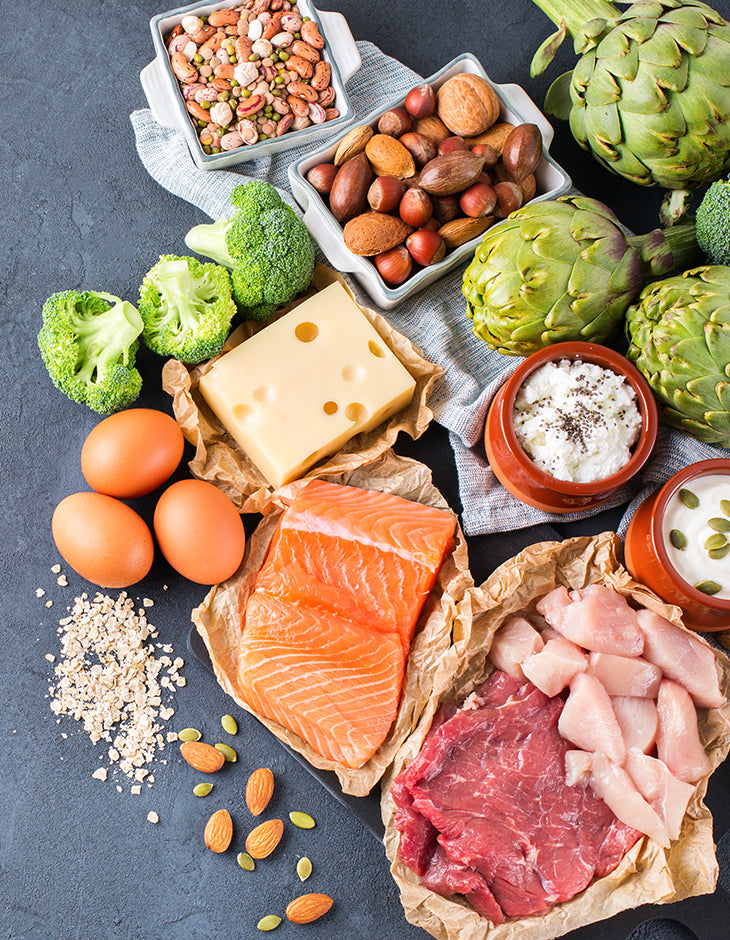
A BEGINNERS GUIDE TO KETOSIS
Everyone is talking about it, but you would be forgiven for having no idea what ketosis actually means. If you haven't heard of keto, it is essentially a diet that involves eating very few carbs but still consuming a high level of fat with the promise that it will help with weight loss. Why do you ask? Because your body will be in what is known as a state of ketosis.
A state of what now?...
What is keto and how does it result in weight loss?
Don't worry; we've got your back.
HERE IS EVERYTHING YOU NEED TO KNOW ABOUT THE KETOSIS DIET, INCLUDING THE FOLLOWING:
- What is the state of ketosis?
- How does the keto diet work?
- How do you achieve a state of ketosis?
- How long does it take to achieve ketosis?
- The science behind ketosis
- How to follow the keto diet correctly
- How do you know if you're in a state of ketosis?
Scroll down to explore whether entering a state of ketosis is right for you, and your goals.
LET'S START WITH THE BASICS, WHAT IS A STATE OF KETOSIS?
Ketosis is a metabolic state in which, rather than getting your energy from blood glucose (essentially carbohydrates), your energy supply comes from what are known as ketones. This will generally occur when the body is metabolizing fat at a higher rate than normal, converting fatty acids into ketones.
HOW DOES THE KETO DIET WORK?
In order to create these ketones, your body has to begin to break down fat, which is only going to do if there isn’t enough blood glucose available. Blood glucose is your body's first port of call when it comes to producing energy, digesting carbohydrates and converting them to glucose, before entering the bloodstream.
Take those carbohydrates away, and your body has to start utilizing fat stores as it's main energy source, consequently producing ketones.
It might be the second choice for your body but reaching this state of ketosis is the first choice for many people looking at shedding weight, ketosis advocates worldwide swearing by its effectiveness for weight loss.
HOW DO YOU ACHIEVE A STATE OF KETOSIS?
To be in a state of ketosis, your carbohydrate intake has to be at a low enough level to force the body to resort to fat stores for energy. While the exact amount of carbs is up for debate, most diets will recommend around 50g of carbohydrates per day and around 1.5g of protein per kilogram of body weight should help achieve the state of ketosis.
HOW LONG DOES IT TAKE TO ACHIEVE KETOSIS?
Achieving ketosis does not happen overnight.
You can't achieve ketosis in 24 hours, or even in a couple of days. Our bodies will have a significant amount of glycogen to utilize first, before reverting to fat stores. This is why your carbohydrate intake must be kept below 50g per day, giving your body time to shift its energy source.

THE SCIENCE BEHIND KETOSIS
Older studies supported the keto diet, revealing that endurance athletes who were on high-fat, low-carb diets burnt twice as much fat when compared to those following a high-carb diet – pretty impressive right?
But, hold up a second.
If we flash forward to 2018, the science is not quite so positive about the ketosis diet. Researchers from Saint Louis University revealed that those who followed a low-carb diet did not perform as well in aerobic activities.
It, therefore, followed that, unless there are compelling health reasons for following a low-carb diet, then being in a calorie deficit alone will help you to lose weight, while also maintaining your aerobic fitness levels.
The risk of having a diet predominantly made up of saturated fat is also a concern for science, as this has been linked to cardiovascular disease and other health issues. Unless done correctly, a keto diet could also lead to nutrient deficiency. Resulting in a negative effect on your health, rather than the positive impact you may have been hoping for.
SO, HOW DO YOU MAKE SURE YOU'RE FOLLOWING THE KETO DIET CORRECTLY?
So, you've decided the ketosis diet may be right for you? Here are a couple of common mistakes associated with the ketosis diet, and how to avoid them...
1. SEEING THE KETOSIS DIET AS A ‘QUICK FIX’
The keto diet is not a quick fix!
To see results it is something you have to stick with as your body adjusts to using different sources of energy. To see changes that are going to be sustainable in the long-term, the keto diet also has to be long-term.
2. BEING SCARED TO EAT FATS
Yeah, we know that eating fat to lose fat seems a little counterproductive, but it is this basis that the keto diet works on. The whole point of this diet is to consume a large amount of fat, so don’t be scared of it.

3. EATING THE WRONG TYPE OF FAT
On the keto diet you need to be mindful of the quality of food you are eating. The majority of your intake should be coming from unsaturated fats such as avocados, nuts, fish and vegetable oils.
This is not to say you can’t have saturated fats, but these should not be making up the majority of your intake.
4. EATING AN EXCESS OF PROTEIN
When you’re pretty much cutting out one macro-group, it can be easy to over-compensate with another. Make sure you’re giving your body what it needs in terms of your protein intake, but not overdoing it. Any unnecessary protein will begin to be converted into fat, which is something that you’re trying to avoid.
A good way to make sure you’re on top of this is to track your macros using an app – this will help you monitor your intake and keep you hitting your goals.
5. NOT DRINKING ENOUGH WATER
Staying hydrated is always important, but this becomes even more vital when starting out on the keto diet.
Without getting too complicated, this is basically because when you cut your carbs, your liver releases glycogen. For every gram of glycogen released, 2 grams of water is also released. You need to be making sure you’re replacing the water that is being lost. As always, aim for at least 2.5l of water every day!
HOW DO YOU KNOW IF YOU'RE IN A STATE OF KETOSIS?
There is no easy way to know if you're in a state of ketosis, and the side effects are different for everyone. However, there are a few symptoms that you might want to look out for.
Studies have shown that a ketogenic diet could result in dehydration, and so it is important to make sure you're drinking plenty of water to counteract any water loss. This can also cause muscle cramps and headaches due to dehydration and an electrolyte imbalance. You might always find that for the first few weeks you experience feelings of fatigue and therefore do not perform as well in the gym. This is due to the switch from burning carbohydrates for energy to burning fat stores.
However, it is not all bad. If you're aiming to lose weight, a keto diet has been shown to help due to burning fat stores. Research has also shown that people following a ketogenic diet long-term have greater focus and concentration.
Due to the huge variety of side effects, if you're considering following a keto diet, we would, therefore, recommend speaking to your doctor prior to as a low-carbohydrate diet might not be suitable for everyone.
So, there you have it! Next time you see something on the keto diet, you know all about what it is and how it works.



Leave a comment
This site is protected by hCaptcha and the hCaptcha Privacy Policy and Terms of Service apply.